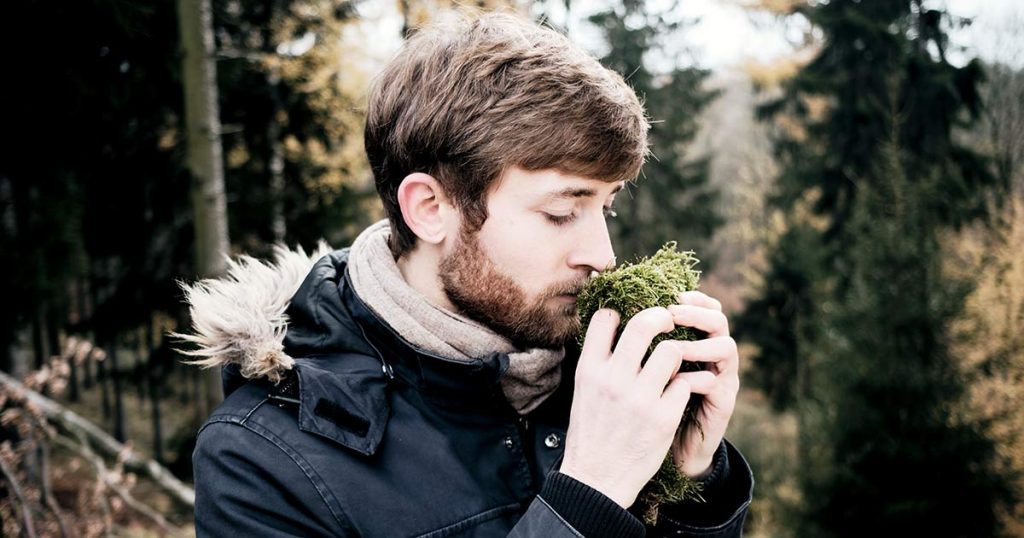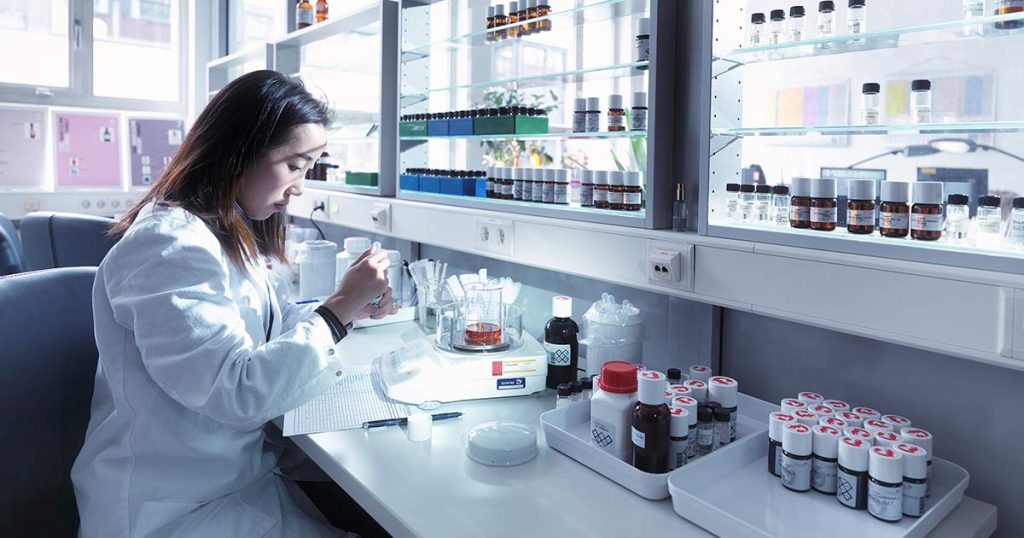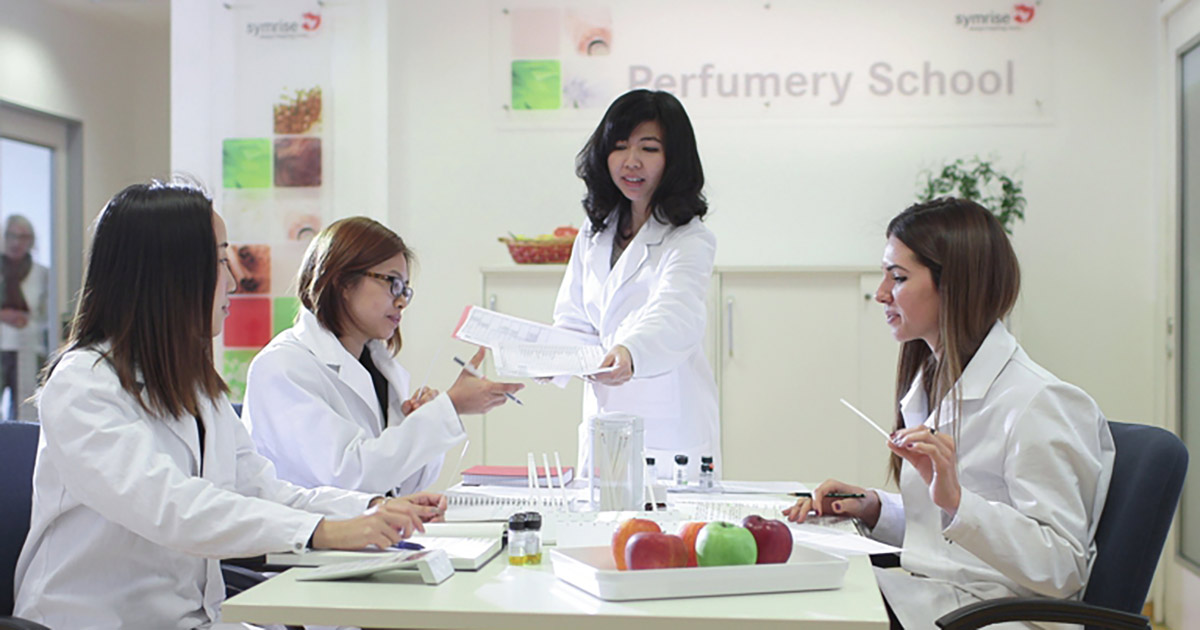Cette publication est également disponible en :
Français
This article was published in partnership with Symrise.
Since 2007, Symrise’s in-house school of perfumery has aimed to accompany, train and develop up-and-coming perfumers. It is estimated that it takes around twelve years to become a senior perfumer. Symrise must therefore use a long-term perspective in order to ensure it constantly provides creative resources. In little over 10 years, the company has produced 30 noses, located in its creative centres across the world.
Although not a prerequisite, joining an in-house training programme can be decisive for aspiring perfumers. Marine Ipert, a young graduate of the Symrise school, tells us: “In order to become a perfumer, the way in is through an in-house training centre”. It is indeed the best route, following on from schools such as Isipca (International Superior Institute of Perfume, Cosmetics and Food Flavours), ESP (Superior School of Perfumery) and GIP (Grasse Institute of Perfumery). At Symrise, students study for a further four years in order to perfect their skills, master the basics and discover different categories of perfumery (Fine, Beauty, Home) as well as regional specificities.
Spurred on by Béatrice Favre-Bulle, Senior Vice President for Perfumery Excellence and Sustainability, the company put in place a chart that outlined creative strength based on age. “Trying to identify the candidates who will one day become successful perfumers is one of the most difficult tasks,” Véronique Ferval, Vice President in the Global Creation Fine Fragrances department, confesses. Investing in the future by identifying and recruiting these young talents is one of the key contributing factors to the success of the company, and it should continue for decades to come.
A perfumer is like an architect
“For me, a perfumer is like an architect. He must know how to respond to purely technical constraints, as well as build in a creative way,” Véronique Ferval explains. “We have to find candidates who have an almost mathematical brain, who are curious, have an interesting cultural background and want to reach consumers on an emotional level.” Students who have chemist training and have attended a perfumery school are given priority, but “what matters is obviously having an excellent sense of smell and the capacity to memorise scents”, Béatrice Favre-Bulle points out. “Working as a laboratory technician or perfumer in house is a real advantage for the candidate as they learn about the innerworkings of the company. It also means we can get to know them and evaluate their capacity to work in a team and receive feedback. The admissions tests are the same for everybody,” Béatrice Favre-Bulle insists. “We make them take exams in olfaction and English, as well as an Occupational Personality Questionnaire, which measures several of the candidate’s skills, such as their ability to take the lead on a project or to resolve complex problems without having all the information – typical challenges when confronted with a brief!”.
The candidates selected for the perfumer-creator or technical perfumer programmes – one of whose many goals will be seeking to replace currently unavailable raw materials or to replace materials lacking due to new regulations – are invited to Holzminden in Germany, the historic heart of the company. They explain their motivation and prove their determination in front of a panel of several people, just as they would do if speaking to a client. Knowing how to communicate and receive feedback is key. “I don’t see how a perfumer who sits at his desk all day, without ever going outside or exchanging with his evaluators or clients, could possibly improve!” ,Béatrice Favre-Bulle tells us.
Total immersion
The HQ at Holzminden, viewed as “a bubble”, welcomes students for their first years of training. Former student Suzy Le Helley describes the town located in the centre of the country as the “Grasse of Germany”. “Its inhabitants were a large part of perfume history; some have worked for Symrise for 30 or 40 years and have decades worth of knowledge to share. It’s fascinating!”. During this period, she continues, “my curiosity could finally be satisfied! If I wanted to look up old formulas or look through old books, the Symrise library had all the references about perfumery accessible to me.” Moreover, the students of course have access to the entire olfactory archives of the company, the current palette in use as well as raw materials removed from the market, such as the Laire bases or discontinued perfume formulas. They have everything, simply available upon request. It is a true Ali Baba’s cave for these aspiring perfumers.
Far away from the commercial pressure they face in their roles today, the alumni all insist upon how much freedom they had and how they benefited from the gift of time throughout their years at Holzminden. They were free to come and go from the production sites in order to discover the different facets of the Symrise machine and they had “the time to explore, smell, create, and go deeper,” Leslie Gauthier, who followed the course a few years ago, reveals. It is a period when the perfumers learn, develop their ranges at their own pace and create their first accords, which at first are very simple. For their first fruit and flower accords Mathias Werner, Senior Perfumer in charge of training young talents, teaches a class following the seasons, making the students work on freshly picked ingredients. The starting point of their work is a walk in the forest, in search of a woodland mushroom accord, strawberry picking or a tasting of dozens of apple varieties. Their accords grow more complex as the months go by and the perfumers gradually start working on classic perfume formulas such as Fahrenheit by Dior or a traditional Nivea cream. During their training, the perfumer-creators and technical perfumers build their own tool box. Gradually, “we create our database of raw materials, our personal bible including descriptions, olfactory families, origins, molecules and the Symrise codes associated with those products. Even today I still use a lot of these accords as a basis for the creation of my perfumes,” Leslie Gauthier explains.

Team spirit and collaboration
When students are taken on, they join a group of five to six students being trained simultaneously, coming from different continents: Asia, Latin America, Europe. “Learning together means we discover the cultural influence of each person’s respective olfactory knowledge. That’s essential for later on,” Leslie Gauthier tells us enthusiastically. Having gone from Symrise headquarters in Barcelona and Paris, she now works in São Paulo. During the course students do not study alongside each other but really collaborate on the same projects, in an “open source” style. For example, the formulas of the best accords are systematically shared with the whole group. There is no room for secrecy here!
“Beyond our work together, we create a sense of camaraderie and that leads on to develop team spirit, which is valued at Symrise. There is true transparency and trust created between students in a given year group, but also from one cohort to another,” Véronique Ferval remarks. This is of course a way to reinforce and set up corporate culture, but it is also a very on-trend approach in creative industries today. “We find the same thing in fashion, in design and in architects’ offices, but in perfumery I think we are further ahead,” Véronique Ferval insists. “Working as a team doesn’t necessarily mean doing the same thing as each other. It means bringing a different point of view, and for that, people need to be able to understand one another,” she points out. Attending the same school offers a chance to develop a common language in order to better create together, and for others.
The last two years of the perfumer-creator course take place in creative centres across the world where each student is accompanied by a mentor. A senior perfumer teaches the tricks of the trade and transmits his own working methods. Isaac Sinclair tells us it is exceptional to learn in this hands-on manner: “Maurice Roucel looked at my formulas, asked me about my compositions and taught me good practices.” Suthathip Thedvichienchai, a young Thai creator, confirms the importance of this stage of the course: “Working with several mentors, in several countries and across different categories allowed me to discover each person’s style and the diversity of their techniques.” She tells us that this is a decisive for creating one’s own style and moving towards independence.

The programme concludes with a “masterpiece”, “a research and development project in response to a current issue faced by Symrise,” Marine Ipert explains. Innovative thinking is encouraged for this project which is presented in front of an examining board, as for a PhD. Some examples of topics include: research into renewable and sustainable materials that could be added to the Symrise palette; looking for alternative and more sustainable ingredients that risk extinction or exploring the use of new technologies being developed by the R&D team. Research topics are diverse but must be linked to issues the perfume industry faces today, because “wanting to be a perfumer means learning constantly. It’s about remaining curious and having an open mind, working hard, never losing heart, being tenacious and knowing how to take risks,” Véronique Ferval concludes.
www.symrise.com
Instagram – @finefragrancestories_bysymrise
Credit forest image: Daniel Kunzfeld Photography








Hello
How can i take part in perfumery school?